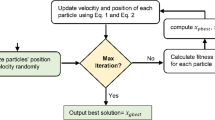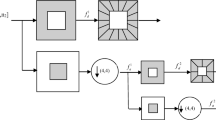Abstract
A novel image fusion technique is presented, aiming at resolving the fusion problem of noisy images. In this paper, a new activity level measurement based on consecutive pixel intensity similarity is proposed for detecting the noise free and noisy parts from the source images and also the fusion technique is optimized using particle swarm optimization for obtaining the optimized fused image. Experiments have been made on images affected by Gaussian noise, salt and pepper impulsive noise, speckle noise and Poisson noises for examining the efficiency of the proposed algorithm. The proposed framework is evaluated using quantitative metrics such as root mean square error, peak signal to noise ratio, mean absolute error, percentage fit error, structural similarity index and mutual information. The experimental results demonstrate the outperformance of the proposed algorithm over many other well known state-of-the-art fusion techniques reported in the literature.









Similar content being viewed by others
References
Abdipour M, Nooshyar M (2016) Multi-focus image fusion using sharpness criteria for visual sensor networks in wavelet domain. Comput Electr Eng 51:74–88
Boyat AK, Joshi BK (2015) A review paper: noise models in digital Image processing. Signal Image Proc: Int J (SIPIJ) 6(2)
Cao L, Jin L, Tao H, Li G, Zhuang Z, Zhang Y (2015) Multi-focus Image Fusion Based on Spatial Frequency in Discrete Cosine Transform Domain. IEEE Sign Proc Lett 22:(2)
Cvejic, Canagarajah, Bull (2006) Image fusion metric based on mutual information and Tsallis entropy. Electron Lett 42(11)
De Vore, Jawerth, Lucier (1992) Image compression through wavelet transform coding. IEEE Trans on Inf Theory 38(2):719–746
Deepalaxmi, Balaji, Rajini (2013) Particle Swarm Optimization Based Selection of Optimal Polymeric Blend. IEEE Trans Dielect Electric Insul 20(3)
Eberhart RC, Kennedy J (1995) A new optimizer using particle swarm theory. Proceedings of the Sixth International Symposium on Micro Machine and Human Science, New York, pp 39–43
Guihong Q, Zhang D, Yan P (2002) Information measure for performance of image fusion. Electron Lett 38(7):313–315
http://decsai.ugr.es/cvg/CG/base.htm (accessed on 18/05/2018)
http://it.mathworks.com/help/images/ref/fspecial.html (accessed on 18/05/2018)
http://it.mathworks.com/help/images/ref/imnoise.html (accessed on 18/05/2018)
http://www.ece.uwaterloo.ca/~z70wang/research/ssim/ (accessed on 09/05/2018)
https://figshare.com/articles/TNO_Image_Fusion_Dataset/1008029 (accessed on 18/05/2018)
Indu CR (2009) Image fusion algorithm for impulse noise reduction. Inte Conf Adv Recent Technol Commun Comput, Kottayam, Kerala, India, 27–28 October 2009
Kausar N, Majid A, Javed SG (2016) A novel ensemble approach using individual features for multi-focus image fusion. Comput Electr Eng 54:393–405
Khan SU, Khan NU, Chai WY (2016) Impulse Noise Reduction using Image Fusion Approach. The sixth international conference on innovative computing technology (INTECH)
Li X, Ni L (2015) Compressive Image Fusion Based on Particle Swarm Optimization Algorithm”, International Conference on Electronic Science and Automation Control (ESAC). Published by Atlantis Press
Li H, Chai Y, Ling R, Yin H (2013) Multifocus image fusion scheme using feature contrast of orientation information measure in lifting stationary wavelet domain. J Inf Sci Eng 29:227–247
Liu Y, Liu S, Wang Z (2015) A general framework for image fusion based on multi-scale transform and sparse representation. Info Fusion 24:147–164
Loza A, Bull D, Canagarajah N, Achim A (2010) Non-Gaussian model-based fusion of noisy images in the wavelet domain. Comput Vis Image Underst 114:54–65
Naidu VPS, Raol JR (2008) Pixel-level image fusion using wavelets and principal component analysis. Defense Sci J 58(3):338–352
Nejati M, Samavi S, Karimi N, Reza Soroushmehr SM, Shirani S, Roosta I, Najarian K (2017) Surface area-based focus criterion for multi-focus image fusion. Info Fusion 36:284–295
Paramanandham N, Rajendiran K (2017) Multi sensor image fusion for surveillance applications using hybrid image fusion algorithm. Multi Tools Appl 1–32
Paramanandham N, Rajendiran K (2018) Infrared and visible image fusion using discrete cosine transform and swarm intelligence for surveillance applications. Infrared Phys Technol 88:13–22
Rahman M, Ahmad O, Swamy MNS (2010) Contrast-based fusion of noisy images using discrete wavelet transform. IET Image Process 4(5):374–384
Raol JR (2010) Multi-sensor data fusion with Matlab. CRC Press, Taylor and Francis Group
Srivastava K (2015) Multifocus noisy image fusion using contourlet transform. Imaging Sci J 63(7):408–422
Srivastava, Singh, Khare (2016) Fusion of multifocus noisy images using contourlet transform. Contemporary Computing (IC3), 2013 Sixth International Conference on, Noida 497–502
Toet A, Hogervorst MA, Nikolov SG, Lewis JJ, Dixon TD, Bull DR, Canagarajah CN (2010) Towards cognitive image fusion. Info Fusion 11:95–113
Wang Z, Ziou D, Armenakis C, Li D, Li Q (2005) A Comparative Analysis of Image Fusion Methods. IEEE Trans Geosci Remote Sensing 43: (6)
Yang Y, Tong S, Huang S, Lin P (2015) Multifocus Image Fusion Based on NSCT and Focused Area Detection. IEEE Sensor J
Author information
Authors and Affiliations
Corresponding author
Rights and permissions
About this article
Cite this article
Paramanandham, N., Rajendiran, K. Swarm intelligence based image fusion for noisy images using consecutive pixel intensity. Multimed Tools Appl 77, 32133–32151 (2018). https://doi.org/10.1007/s11042-018-6233-9
Received:
Revised:
Accepted:
Published:
Issue Date:
DOI: https://doi.org/10.1007/s11042-018-6233-9




